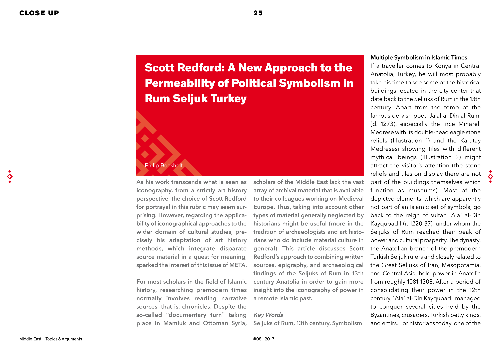Scott Redford: A New Approach to the Permeability of Political Symbolism in Rum Seljuk Turkey
As his work transcends what is seen as iconography, from a strictly art history perspective, the choice of Scott Redford for portrayal in this rubric may seem surprising. However, regarding the applicability of iconographical approaches to the wider domain of cultural studies, precisely his adaptati...
Gespeichert in:
| Veröffentlicht in: | Middle East - Topics & Arguments |
|---|---|
| 1. Verfasser: | |
| Format: | Daten Artikel (Zeitschrift) |
| Sprache: | Englisch |
| Veröffentlicht: |
Philipps-Universität Marburg
2017
|
| Schlagworte: | |
| Online Zugang: | Datensatz ansehen Online Zugang |
| Tags: |
Tag hinzufügen
Keine Tags, Fügen Sie den ersten Tag hinzu!
|
| Zusammenfassung: | As his work transcends what is seen as iconography, from a strictly art history perspective, the choice of Scott Redford for portrayal in this rubric may seem surprising. However, regarding the applicability of iconographical approaches to the wider domain of cultural studies, precisely his adaptation of art history methods, which integrate disparate source material in a quest for meaning, sparked the interest of this issue of META.For most scholars in the field of Islamic history, researching premodern times normally involves reading narrative sources, that is, chronicles. Despite the so-called "documentary turn" taking place in Mamluk and Ottoman Syria, scholars of the Middle East lack the vast array of archival material that is available to their colleagues working on Medieval Europe. Thus, taking into account other types of material generally neglected by historians might be useful (more in the tradition of archaeologists and art historians who do include material culture in general). This article discusses Scott Redford's approach to combining written sources, epigraphy, and archaeological findings of the Seljuks of Rum in 13th century Anatolia in order to gain more insight into the iconography of power in a remote Islamic past. |
|---|---|
| DOI: | 10.17192/meta.2017.8.6213 |
 Publikationsserver
Publikationsserver